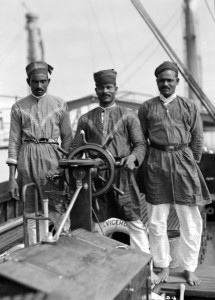 The story of the settlement of south Asians in Britain is full of colour, curiosity, souvenirs and…struggles. To make a permanent home was not possible without challenges. Asians have been engaged in a variety of economic activities, demonstrating their resourcefulness and capability to adapt. But all this didn’t occur without labour.
The story of the settlement of south Asians in Britain is full of colour, curiosity, souvenirs and…struggles. To make a permanent home was not possible without challenges. Asians have been engaged in a variety of economic activities, demonstrating their resourcefulness and capability to adapt. But all this didn’t occur without labour.
The relationship between Britain and India began with the establishment of the East India Company in 1600. That provoked major changes in the culture and history of both nations. Migrations between the British Isles and the Indian sub-continent continued since then. At that time the direction was one way – that is, British citizens heading towards the sub-continent. Among the first arrivals to India were British sailors, merchants, soldiers and businessmen. Missionaries and clerks, teachers and bureaucrats of the British Empire later joined them.
The earliest Asian working class settlers in Britain
During this early period, the British employed the Indian Lascars due to their knowledge of the seas. A lascar was a sailor from the Indian subcontinent. They were employed on European ships from the 16th century until the middle of the 20th century. A number of them created small settlements in British ports. They settled down with British women.
They had to find alternative ways to earn their living; some sold Indian spices or set up cafés. Others found odd jobs working as street herbalists or sold Christian tracts. They were the earliest Asian working class settlers in Britain. Those who were unable to find jobs worked as hawkers, street musicians- some resorted to begging.
A testimony from a street musician in a book entitled, London Labour of the London Poor, stated: “I put up many insults in dis contree. I struck sometime in street. Magistrate punish man gave me blow dat left mark on my chin here. Gentlemen sometime save me from harm, sometime not. De boys call me black dis or de oder. Wen I get o service, I not live, and I not beg in street, so I buy tom-tom for 10s. De man want 30s. De 10s. my last money left, and I start to play in street for daily bread. I beat tom-tom, and sing song about gratness of God, in my own language. …I sometime get few shilling from two or three picture-men, who draw me…”
The destiny of Sake Dean Mahomed
 Sake Dean Mahomed was a Lascar; a soldier in the East India Company (Bengal Regiment) as trainee surgeon. He was born in 1759 in Patna, India. He came from an elite Muslim family. When his father died, he entered service at age 11under British captain Godfrey Baker. He worked for him for 13 years. When Captain Baker returned to Ireland, Mahomed followed him. They had become close friends. He got married to Jane Daly, the daughter of an Irish family.
Sake Dean Mahomed was a Lascar; a soldier in the East India Company (Bengal Regiment) as trainee surgeon. He was born in 1759 in Patna, India. He came from an elite Muslim family. When his father died, he entered service at age 11under British captain Godfrey Baker. He worked for him for 13 years. When Captain Baker returned to Ireland, Mahomed followed him. They had become close friends. He got married to Jane Daly, the daughter of an Irish family.
In 1810, Sake Dean Mahomed and Jane moved to London. There, he established the Hindoostane Coffee House at 34 George Street, in the Portman Square, in the heart of London. It was the first Indian take away restaurant in England. However, this venture failed within two years.
Let there be shampoo, and there was shampoo!
In 1814, Dean and his wife Jane moved to Brighton. They opened the first shampooing vapour masseur bath. He altered the Urdu word ‘champi’ into what we call ‘shampoo’, today. He described the treatment in a local paper as: “The Indian Medicated Vapour Bath, a cure to many diseases and giving full relief when everything fails- particularly rheumatic and paralytic, gout, stiff joints, old sprains, lame less, aches and pains in the joints”.
He advertised other products in the newspaper, such as: “INDIAN TOOTH POWDER, which possesses extraordinary excellence. It is the first ever offered to the public in this country…also just introduced from India, the celebrated CULEFF [kalaf, Persian for red-black hair dye], for changing the Hair, of whatever colour it might be, to a beautiful glossy permanent BLACKNESS, which will ever remain unaffected by the attacks of time.”
Their success and their family grew. Dean Mahomet claimed to have treated a thousand cases. Both King George IV and William IV appointed him as their shampooing surgeon in Brighton.
The first English book written by an Indian
He was the first Indian to write and publish a book in English in 1794. The book is entitled, The Travels of Dean Mahomet, A Native of Patna in Bengal Through Several Parts of India While in the Service of the Honourable East India Company. He wrote a second book in 1820, called, The Benefits Resulting from the Use of Indian Medicated Vapour Bath.
Sake Dean had five sons, William, Dean Mahomed, Horatio Mahomed, Arthur Ackber and Frederick Mahomed; three followed the father’s profession. Mahomed died in February 1851. He was buried in St Nicholas churchyard in Brighton.
According to Pakistani literary critic Muneeza Shamsie, Sake Dean Mahomet began to lose prominence by the Victorian era and until recently was largely forgotten by history.





















